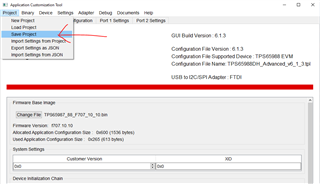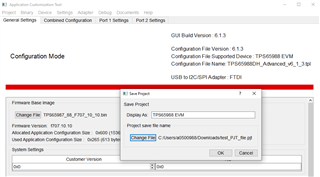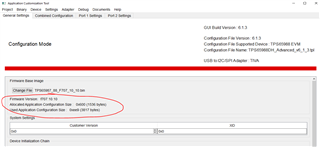Part Number: TPS65988EVM
Hello,
TPS65988 will be connected over I2C to a MCU. Port A if for connecting to a power adapter and Port B is for a device that needs communication and charging,
External flash purpose: In the datasheet is written that the external flash is optional, but seems it is not. I am not sure did I understand it, but correct me, please, if needed. This device has a built-in firmware, but it requires external flash to be uploaded a new up-to date firmware in case TI finds some issues? The flash is needed and for storing settings, TPS65988 to be able to work in a stand alone mode? Can you give a list of flash ICs that are supported? So in every flash is always needed to be written the generated bin, by the MCU over I2C through TPS65988 over SPI when the device is started for a first time?
BIN FILES: I tried to save bin file from the GUI, but I got an error: The size of the app config data table generated by this project (0xee9 bytes) is larger than the allocated region supported by the firmware image (0x600 bytes). Save operation has been aborted.
Dead battery: here my EVM get damaged and I wasn't able to finish the experiments, but... I want the TPS65988 to be able to activate just 5V of the adapter (not the maximum available as it happens up to now). If I want to be used default Configuration 2: ( UFP only (Internal Switch) 5 V at 0.9 - 3.0 A Sink capability), is needed to have a divider ratio at ADCIN1 around 0.25 and 0V at SPI_POCI. But if I connect SPI_POCI (MISO) to ground the external flash will not operate.




